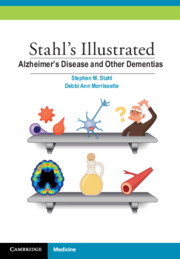Book contents
- Frontmatter
- Dedication
- Preface
- Contents
- CME Information
- Objectives
- Introduction
- Chapter 1 Alzheimer’s Disease
- Chapter 2 Lewy Body Dementias and Other Synucleinopathies
- Chapter 3 Frontotemporal Lobar Degeneration and Tauopathies
- Chapter 4 Other Dementias
- Chapter 5 Treatment of Secondary Behavioral Symptoms of Dementia
- Summary
- References
- Index
- Optional Posttest and CME Certificate
Chapter 5 - Treatment of Secondary Behavioral Symptoms of Dementia
Published online by Cambridge University Press: 19 October 2021
- Frontmatter
- Dedication
- Preface
- Contents
- CME Information
- Objectives
- Introduction
- Chapter 1 Alzheimer’s Disease
- Chapter 2 Lewy Body Dementias and Other Synucleinopathies
- Chapter 3 Frontotemporal Lobar Degeneration and Tauopathies
- Chapter 4 Other Dementias
- Chapter 5 Treatment of Secondary Behavioral Symptoms of Dementia
- Summary
- References
- Index
- Optional Posttest and CME Certificate
Summary
As we have seen, the majority of dementias have no disease-altering therapeutic interventions currently available. Treatment options are thus limited to symptomatic presentations and strive to relieve patients and caregivers of some of the behavioral and psychiatric sequelae that can severely impact the quality of life. In fact, neuropsychiatric symptoms of dementia affect virtually all patients with dementia at some time during the disease course and are associated with earlier institutionalization, increased caregiving costs (both financial and otherwise), and worsened disease progression. Unfortunately, pharmacological measures acting on neurocircuitry that may be damaged in the brains of patients with dementia as well as attempts to utilize non-pharmacological, cognition-acting strategies in cognitively impaired patients with dementia may not be as effective as they are for younger, non-demented patients. It is also important to note that improvements in behavioral symptoms (e.g., depression) may be due not solely to a prescribed psychotropic agent but may also be a result of the extra social contact with the treatment team that medication warrants.
In this chapter, we will discuss some of the behavioral symptoms of dementia as well as treatments that may be potentially therapeutic or potentially contraindicated. It should be noted that first-line treatment of any behavioral symptom associated with dementia should always be non-pharmacological. We will also address a very important issue—namely the well-being of those who care for patients living with dementia (Lanctot et al, 2017; Cepoiu-Martin et al, 2016; Hongisto et al, 2018; Van der Linde et al, 2016).
Non-pharmacological Options for Behavioral Symptoms in Dementia
- Type
- Chapter
- Information
- Stahl's Illustrated Alzheimer's Disease and Other Dementias , pp. 149 - 198Publisher: Cambridge University PressPrint publication year: 2018



